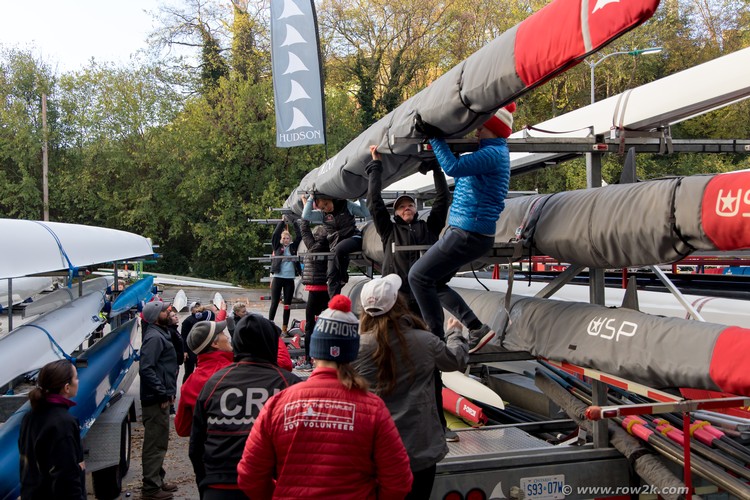
The sea is not the enemy; it's that damned hard stuff all around it." -- sailors' proverb
Most serious damage to crewshells occurs on land, rather than on water. Space is more confined, and there are more hard things (trailers, trees, fire hydrants, "Unsafe Ice" signs, the riggers of other boats, etc.) just waiting to jump out and smack your shell the moment your back is turned. Maneuvering a crewshell on land, especially at crowded regattas, can be the most nerve-wracking part of the day. There is no microphone and speaker system to amplify the coxswain's voice, and there are often many distractions -- audio and visual -- which can make projecting the commands more difficult. At busy regattas, you may have to thread the bow or stern partway through the trailers beside or across from yours just to get enough space to turn it, or cant it sideways through an opening between other shells on racks.
Moving a shell smoothly and safely on land not only preserves the equipment, it is also an opportunity for a coxswain to make a huge psychological pre-race contribution by getting his or her rowers to the launch dock calmly and confidently.
The coxswain's place is always at the Point of Greatest Hazard. Typically this will be the bow, but often shifts depending on which way the shell is being walked, or spun, so the coxswain must shift from bow to stern while somehow keeping the entire length of the shell visible. With the shell on their shoulders, the hull at face-level blocks your rowers' field of vision pretty thoroughly, both down and to the side. You cannot ask your bow or stroke to do the watching for you. With the best of intentions, they simply won't be able to see. If the timing is such that there is a temporarily idle coxswain on your crew available to watch your stern as you carry the shell down, so much the better, and be prepared to return the favor. (Special thanks here to a certain Army coxswain who was very effective at stopping traffic on Memorial Drive while the rest of us got our shells across.)
Walk the route to the launch area ahead of time and plan what you are going to do so that there is no wasted movement. Pre-select the best place to spin the shell if you need to. (There's nothing more embarrassing than arriving stern-first.) Explain the route to your rowers before hands-on so they know ahead of time what to look for, and can avoid those moments of indecision. "We're going to take it between the X and Y trailers; cross the six-lane highway and the railroad tracks; pass it over the hood of the SUV; spin it next to the ambulance, then press it over our heads as we walk it down through the poison ivy..."
When moving a shell in tight quarters next to a rack or trailer crosstrees, it is traditional to cant it down to the side away from the rack (or whatever the hazard is). This is safer, and provides slightly better visibility for the rowers closest to the hazard.
Standing with a shell at shoulders for any length of time is tiring for many rowers, so you can do your rowers who need a break a huge favor by taking it to waists whenever the wait is going to be more than a short pause. Where there is a long queue to the launch area, the coxswain should bring a set of slings to set under the boat at periodic stops. This is particularly true at crowded head races. (At one regatta, we timed the walk from hands-on to launch dock as 51 minutes!) "Er, ladies and gentlemen, Departure Control is advising us that we're number twenty in line for takeoff, so we'll be showing a short movie in the main cabin..."
When spinning in close quarters, you can minimize the danger by pivoting one end of the shell. With only one end moving, you can concentrate on the end which is swinging.
Taking a shell down a ramp puts more weight on the people at the lower end. If the angle is steep, press it over heads to avoid hitting the bow or stern, and to make it easier to carry. Small steps, slow. Docks can be slippery as ice, even when only slightly wet, and there are often hazards underfoot such as oars, which the coxswain should warn the rowers of. Dockmasters can be your allies here, so follow their instructions and suggestions thoroughly.
Returning can be just as tricky, and -- to rowers tired from the race -- even more tedious. One Yale lightweight crew cut the proverbial Gordian knot by passing their 8+ directly across the dock, over the seawall, and through a gap in the hedge to their compatriots on shore. It was a virtuoso piece of boat handling (not recommended unless you've got about 40 people who know exactly what they're doing).
And yes, it is possible to get a fully-rigged Resolute into a hotel ballroom…(Villanova has done it.)
If you enjoy and rely on row2k, we need your help to be able to keep doing all this. Though row2k sometimes looks like a big, outside-funded operation, it mainly runs on enthusiasm and grit. Help us keep it coming, thank you! Learn more.
- Bont Rowing
- Calm Waters Rowing
- Concept 2
- Craftsbury Sculling
- The Crew Classic
- CrewLAB
- Croker
- Durham Boat Co.
- Empacher
- Faster Masters
- Filippi
- Fluidesign
- h2row.net
- HUDSON
- Live2Row Studios
- Nielsen-Kellerman
- Oak Ridge RA
- Peinert Boat Works
- Pocock Racing Shells
- Race1 USA
- RowKraft
- Rubini Jewelers
- Vespoli USA
- WinTech Racing
- Bont Rowing
- Calm Waters Rowing
- Concept 2
- Craftsbury Sculling
- The Crew Classic
- CrewLAB
- Croker
- Durham Boat Co.
- Empacher
- Faster Masters
- Filippi
- Fluidesign
- h2row.net
- HUDSON
- Live2Row Studios
- Nielsen-Kellerman
- Oak Ridge RA
- Peinert Boat Works
- Pocock Racing Shells
- Race1 USA
- RowKraft
- Rubini Jewelers
- Vespoli USA
- WinTech Racing

















